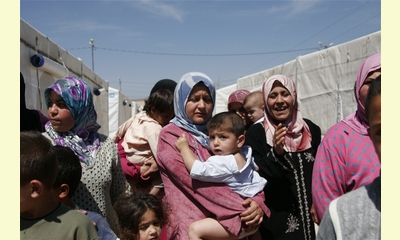|
|
Women and aid
un articulo por IRIN - a service of the UN Office for the Coordination of Humanitarian Affairs
You would be hard pressed to find an aid worker that
thought sexual violence was not an important issue.
But ask them to define what it is, and you may leave
them stumped.

The majority of Syrian refugees, as here in southern Turkey, are women and children. Photo: Patrick Adams/IRIN
click on photo to enlarge
Is it sexual violence, gender-based violence (GBV)
or violence against women and girls? And what
about male victims? How do you address GBV in
patriarchal societies? And how do you balance
collecting evidence-based data with responding to
victims and/or preventing incidents in the first
place?
Researchers at the Humanitarian Practice Network
(HPN) at the Overseas Development Institute (ODI) in
London have been thinking around these questions as
part of a “Good Practice Review” for tackling GBV in
humanitarian contexts.
“We commissioned this work because we felt there was
a gap,” explained Wendy Fenton, HPN coordinator at
the ODI’s Humanitarian Policy Group.
“When we started looking at the issue and talking to
people we realized that there wasn’t even agreement
about what GBV programming or prevention and
response actually was. Even the terminology seems to
be contested.”
They found a wide range of different concepts,
terminologies and priorities, and the researchers
said that in spite of the major advances in
humanitarian and development programming, there
was still a lack of firm consensus about how to
define, prevent and respond to GBV.
The HPN paper Preventing
and responding to gender-based violence in
humanitarian crises authored by Rebecca Holmes and
Dharini Bhuvanendra, was published last month and
will be presented this week at the 11th annual
Dubai International Humanitarian Aid & Development
(DIHAD) conference, which focuses on women and
aid.
Conference panelists will examine the role women
play as essential providers of assistance in
humanitarian crises; the disproportionate impact of
conflict and disasters on women; and how aid is and
should be adapted to meet gender needs.
“Maybe discussing women and aid in the Middle East
is controversial,” DIHAD’s board director, Gerhard
Putman-Cramer, told IRIN. “But if it is, that is
good, because I think it’s healthy to have these
discussions and give the theme some air in a
region where perhaps things may not be 100 percent
as they should be on all scores.”
Putman-Cramer, who has held several director-level
roles with the UN Office for the Coordination of
Humanitarian Affairs (OCHA), added: “It’s only in
the last 10 years or so that countries like the
UAE [United Arab Emirates] have become very active
in the multilateral sphere of the humanitarian
world.
“So I think it’s good to be putting gender topics
on the table. If we’re banging onto an open door,
that’s great, but I don’t think that’s the case.”
(This article is continued in the discussionboard)
Click here for the French version of this article.
|








|
DISCUSSION
No hay pregunta ligada a este article.
* * * * *
Comentario más reciente:
(The following is continued from the main article listed above.)
After evaluating the wide range of practice and policy approaches to GBV and charting programming milestones and initiatives over the years, the 36-page HPN paper concludes that knowledge of gender-based violence in emergencies was “inadequate”.
It adds that owing to “deeply embedded cultural and social norms around GBV, any intervention designed to address its causes, consequences and effects can only work at the margins; bringing about real, meaningful change will be a slow, long-term process, in which humanitarian response can play only a small part.”
Cultural sensitivities can be one of the biggest hurdles in finding consensus about how to respond to GBV in emergencies.
“Because of the hidden nature of GBV (including high rate of underreporting of sexual and other forms of violence) as well as the lack of GBV experts deployed in the early stages of emergencies to assess GBV issues”, writes Jeanne Ward, an independent consultant on GBV in emergencies, “it's often a challenge to counter this view [that GBV is not a critical concern] until well after the emergency has subsided and data can be more routinely collected.
“Some humanitarian actors also maintain that responding to acts of GBV (particularly those not directly related to conflict and displacement) is the preserve of culture and therefore outside the scope of humanitarian intervention.”
Issues of sexual violence have rarely been far from the headlines recently, led by high-profile gang rape cases in India, and other cases in Kenya - and South Africa, as well as reports of child marriage and sexual abuse among Syrians in refugee camps, and the subsequent community action and celebrity-backed campaigns attempting to target rape both domestically and in conflict settings.
In June the UK Foreign and Commonwealth Office (FCO) will host in London a global summit preventing sexual violence in conflict, while its aid agency, the Department for International Development (DFID), has allocated £35 million (US$57.7m) of funding to support campaigns to end female genital mutilation/cutting.
DFID is also introducing a requirement that all its development and humanitarian interventions - from drafting through to evaluation and monitoring - should consider gender equality.
More generally, a revision is also currently under way of the 2005 Inter-Agency Standing Committee Guidelines for Gender-based Violence Interventions in Humanitarian Settings.
In 2012 the UK government launched its Preventing Sexual Violence Initiative with high-profile support from UN Special Envoy for Refugees and Hollywood star Angelina Jolie.
Mukesh Kapila, a former UN mission chief and until recently Under-Secretary-General at the International Federation of Red Cross and Red Crescent Societies, welcomes the profile being given to the causes and campaigns, but he said it needed to be about more than headlines.
“There is clearly money there and these are popular causes,” he told IRIN. . ... continuación.

|
|









